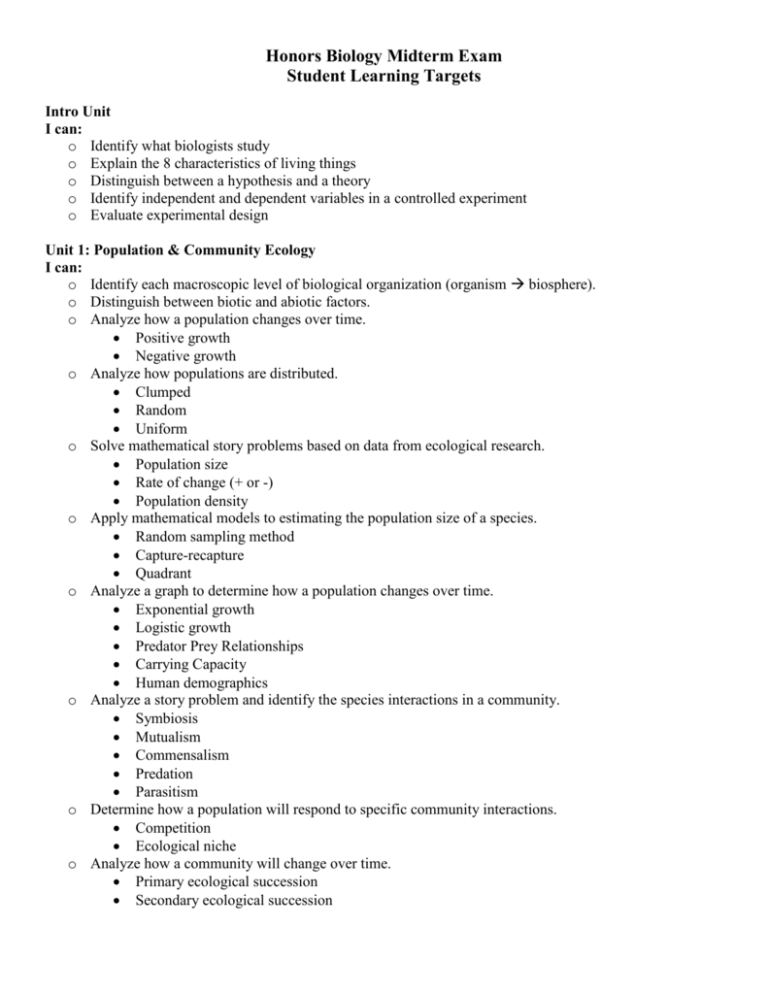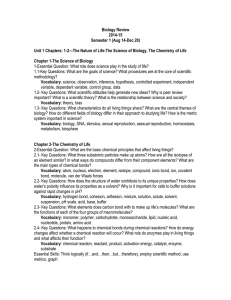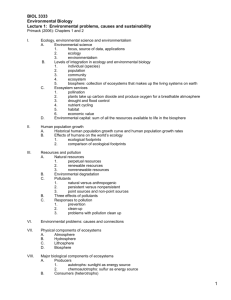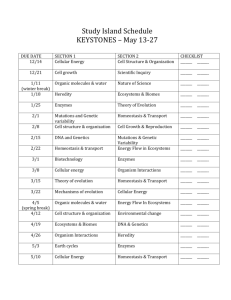STUDY GUIDE - Community Unit School District 308
advertisement

Honors Biology Midterm Exam Student Learning Targets Intro Unit I can: o Identify what biologists study o Explain the 8 characteristics of living things o Distinguish between a hypothesis and a theory o Identify independent and dependent variables in a controlled experiment o Evaluate experimental design Unit 1: Population & Community Ecology I can: o Identify each macroscopic level of biological organization (organism biosphere). o Distinguish between biotic and abiotic factors. o Analyze how a population changes over time. Positive growth Negative growth o Analyze how populations are distributed. Clumped Random Uniform o Solve mathematical story problems based on data from ecological research. Population size Rate of change (+ or -) Population density o Apply mathematical models to estimating the population size of a species. Random sampling method Capture-recapture Quadrant o Analyze a graph to determine how a population changes over time. Exponential growth Logistic growth Predator Prey Relationships Carrying Capacity Human demographics o Analyze a story problem and identify the species interactions in a community. Symbiosis Mutualism Commensalism Predation Parasitism o Determine how a population will respond to specific community interactions. Competition Ecological niche o Analyze how a community will change over time. Primary ecological succession Secondary ecological succession Unit 2: Ecosystems & the Biosphere I can: o Analyze how abiotic factors impact biotic factors in ecosystems. o Explain how matter cycles through ecosystems. Carbon cycle Role of photosynthesis Role of cellular respiration Human impact on o Explain how energy flows through ecosystems. Trophic levels Producers, primary consumers, secondary consumers, tertiary consumers, decomposers Autotroph, heterotroph Herbivore, carnivore, omnivore Food chains Food webs o Solve mathematical story problems based on energy flow in ecosystems. 10% rule o Evaluate the impacts of human activities on the environment and biodiversity Deforestation Pollution – air quality, acid rain Introduction of invasive (non-native) species Global climate change Unit 3: Biochemistry & Cell Structure/Function I can: o Explain the structure and biological function of the following: Organic molecules: Carbohydrates Cellular organelles Chloroplast Mitochondria o Explain how energy flows into and out of an organism: Illustrate light energy chemical energy (glucose) Illustrate chemical energy (glucose) usable chemical energy (ATP) o Explain how matter cycles in the biosphere: Illustrate photosynthesis within an organism: Identify molecular inputs and outputs. Apply the goals of this process to experimental results. Illustrate aerobic cellular respiration within an organism: Identify molecular inputs and outputs. Apply the goals of this process to experimental results. Unit 4: Homeostasis of Organisms I can: o Explain how the structure and biological function of the cell membrane maintain homeostasis and/or enable cell to cell communication: Phospholipid bilayer Cholesterol Receptor proteins Channel proteins Semi-permeability o Explain how feedback mechanisms maintain homeostasis. Stomata Body temperature Blood glucose level Breathing rate o Compare and contrast passive and active transport. o Explain the role of passive transport on homeostasis on plant and animal cells and apply it to story problems. Diffusion Osmosis Hypotonic solutions Hypertonic solutions Isotonic solutions o Explain the role of active transport on homeostasis on animal cells.









